Children’s Self-Reported Reasons for Accepting and Rejecting Foods
Abstract
1. Introduction
2. Materials and Methods
2.1. Participants
2.2. Selection of Stimuli
2.3. Selection of Reasons for Acceptance and Rejection
2.4. Questionnaire
2.5. Study Procedure
2.6. Data Analysis
3. Results
3.1. Children’s Reasons to Accept and Reject Foods
3.2. Results from Open-End Response for Reasons to Accept or Reject Food
3.3. Liking and Willingness to Re-Taste
4. Discussion
4.1. Children’s Reasons for Accepting Foods
4.2. Children’s Reasons for Rejecting Foods
4.3. Liking and Willingness to Re-Taste Specific Foods
4.4. Strengths and Limitations
4.5. Implications for Health Behavior
5. Conclusions
Supplementary Materials
Author Contributions
Funding
Conflicts of Interest
References
- Arimond, M.; Ruel, M.T. Community and International Nutrition Dietary Diversity Is Associated with Child Nutritional Status: Evidence from 11 Demographic and Health Surveys. J. Nutr. 2004, 134, 2579–2585. [Google Scholar] [CrossRef]
- Andersen, R.; Biltoft-Jensen, A.; Christensen, T.; Andersen, E.W.; Ege, M.; Thorsen, A.V.; Knudsen, V.K.; Damsgaard, C.T.; Sørensen, L.B.; Petersen, R.A.; et al. What do Danish children eat, and does the diet meet the recommendations? Baseline data from the OPUS School Meal Study. J. Nutr. Sci. 2015, 4, e29. [Google Scholar] [CrossRef] [PubMed]
- Northstone, K.; Emmett, P. The associations between feeding difficulties and behaviours and dietary patterns at 2 years of age: The ALSPAC cohort. Matern. Child Nutr. 2013, 9, 533–542. [Google Scholar] [CrossRef] [PubMed]
- Rozin, P.; Fallon, A. The acquisition of likes and dislikes for foods. In National Research Council, What is America Eating?: Proceedings of a Symposium; National Academies Press: Washington, DC, USA, 1986; pp. 58–71. [Google Scholar]
- Fallon, A.E.; Rozin, P. The psychological bases of food rejections by humans. Ecol. Food Nutr. 1983, 13, 15–26. [Google Scholar] [CrossRef]
- Fallon, A.E.; Rozin, P.; Pliner, P. The child’s conception of food: The development of food rejections with special reference to disgust and contamination sensitivity. Child Dev. 1984, 55, 566–575. [Google Scholar] [CrossRef]
- Hetherington, M.M. Sensory-specific satiety and its importance in meal termination. Neurosci. Biobehav. Rev. 1996, 20, 113–117. [Google Scholar] [CrossRef]
- Koivisto Hursti, U.-K.; Sjödén, P.-O. Reasons for serving of foods and parental dimensions of food likes and dislikes in Swedish families with children aged 2–17. Näringsforskning 2012, 41, 27–32. [Google Scholar] [CrossRef][Green Version]
- Werthmann, J.; Jansen, A.; Havermans, R.; Nederkoorn, C.; Kremers, S.; Roefs, A. Bits and pieces. Food texture influences food acceptance in young children. Appetite 2015, 84, 181–187. [Google Scholar] [CrossRef]
- Wardle, J.; Sanderson, S.; Leigh Gibson, E.; Rapoport, L. Factor-analytic structure of food preferences in four-year-old children in the UK. Appetite 2001, 37, 217–223. [Google Scholar] [CrossRef]
- Lehto, E.; Ray, C.; Haukkala, A.; Yngve, A.; Thorsdottir, I.; Roos, E. Predicting gender differences in liking for vegetables and preference for a variety of vegetables among 11-year-old children. Appetite 2015, 95, 285–292. [Google Scholar] [CrossRef]
- Caine-Bish, N.L.; Scheule, B.; Ch, E.; Ticle, R. Gender differences in food preferences of school-aged children and adolescents. J. School Health 2009, 79, 532–540. [Google Scholar] [CrossRef] [PubMed]
- Wansink, B.; Cheney, M.M.; Chan, N. Exploring comfort food preferences across age and gender. Physiol. Behav. 2003, 79, 739–747. [Google Scholar] [CrossRef]
- Murimi, M.; Chrisman, M.; McCollum, H.; Mcdonald, O. A Qualitative Study on Factors that Influence Students’ Food Choices. J. Nutr. Heal. 2016, 2, 1–6. [Google Scholar]
- Pollard, J.; Kirk, S.F.L.; Cade, J.E. Factors affecting food choice in relation to fruit and vegetable intake: A review. Nutr. Res. Rev. 2002, 15, 373. [Google Scholar] [CrossRef] [PubMed]
- Koivisto, U.K.; Sjödén, P.O. Reasons for rejection of food items in Swedish families with children aged 2-17. Appetite 1996, 26, 89–104. [Google Scholar] [CrossRef] [PubMed]
- Hughner, R.S.; Maher, J.K. Factors that Influence Parental Food Purchases for Children: Implications for Dietary Health. J. Mark. Manag. 2006, 22, 929–954. [Google Scholar] [CrossRef]
- De Pelsmaeker, S.; Schouteten, J.; Gellynck, X. The consumption of flavored milk among a children population. The influence of beliefs and the association of brands with emotions. Appetite 2013, 71, 279–286. [Google Scholar] [CrossRef]
- Gallo, K.E.; Swaney-Stueve, M.; Chambers, D.H. Comparing visual food images versus actual food when measuring emotional response of children. J. Sens. Stud. 2017, 32, e12267. [Google Scholar] [CrossRef]
- Laureati, M.; Pagliarini, E.; Toschi, T.G.; Monteleone, E. Research challenges and methods to study food preferences in school-aged children: A review of the last 15 years. Food Qual. Prefer. 2015, 46, 92–102. [Google Scholar] [CrossRef]
- Stevens, D.A. Individual differences in taste perception. Food Chem. 1996, 56, 303–311. [Google Scholar] [CrossRef]
- Lafraire, J.; Rioux, C.; Giboreau, A.; Picard, D. Food rejections in children: Cognitive and social/environmental factors involved in food neophobia and picky/fussy eating behavior. Appetite 2016, 96, 347–357. [Google Scholar] [CrossRef] [PubMed]
- Köster, E.P.; Mojet, J. Theories of food choice development. In Understanding Consumers of Food Products; Frewer, L.J., van Trip, J.C.M., Eds.; Woodhead Publishing: Sawston, UK, 2006; pp. 93–124. [Google Scholar]
- De Moura, S.L. Determinants of food rejection amongst school children. Appetite 2007, 49, 716–719. [Google Scholar] [CrossRef] [PubMed]
- Nordin, S.; Broman, D.A.; Garvill, J.; Nyroos, M. Gender differences in factors affecting rejection of food in healthy young Swedish adults. Appetite 2004, 43, 295–301. [Google Scholar] [CrossRef] [PubMed]
- Meiselman, H.L.; MacFie, H.J.H. Food Choice, Acceptance and Consumption; Springer: Boston, MA, USA, 1996. [Google Scholar]
- Cooke, L.J.; Wardle, J. Age and gender differences in children’s food preferences. Br. J. Nutr. 2005, 93, 741. [Google Scholar] [CrossRef] [PubMed]
- Le Bigot Macaux, A. Eat to live or live to eat? Do parents and children agree? Public Health Nutr. 2001, 4, 141–146. [Google Scholar] [CrossRef]
- Pérez-Rodrigo, C.; Ribas, L.; Serra-Majem, L.; Aranceta, J. Food preferences of Spanish children and young people: The enKid study. Eur. J. Clin. Nutr. 2003, 57, S45–S48. [Google Scholar] [CrossRef]
- Laureati, M.; Bertoli, S.; Bergamaschi, V.; Leone, A.; Lewandowski, L.; Giussani, B.; Battezzati, A.; Pagliarini, E. Food neophobia and liking for fruits and vegetables are not related to excess weight in Italian children. Food Qual. Prefer. 2015, 40, 125–131. [Google Scholar] [CrossRef]
- Koivisto Hursti, U.K.; Sjödén, P.O. Food and general neophobia and their relationship with self-reported food choice: Familial resemblance in Swedish families with children of ages 7–17 years. Appetite 1997, 29, 89–103. [Google Scholar] [CrossRef]
- Macalister, H.E.; Ethridge, K. The effect of gendered presentation on children’s food choice. Appetite 2019, 135, 28–32. [Google Scholar] [CrossRef]
- Blom, W.M.; Vlieg-Boerstra, B.J.; Kruizinga, A.G.; van der Heide, S.; Houben, G.F.; Dubois, A.E.J. Threshold dose distributions for 5 major allergenic foods in children. J. Allergy Clin. Immunol. 2013, 131, 172–179. [Google Scholar] [CrossRef]
- Braun, V.; Clarke, V. Using thematic analysis in psychology. Qual. Res. Psychol. 2006, 3, 77–101. [Google Scholar] [CrossRef]
- Schouteten, J.J.; Verwaeren, J.; Lagast, S.; Gellynck, X.; De Steur, H. Emoji as a tool for measuring children’s emotions when tasting food. Food Qual. Prefer. 2018, 68, 322–331. [Google Scholar] [CrossRef]
- Ares, G.; Jaeger, S.R.; Bava, C.M.; Chheang, S.L.; Jin, D.; Gimenez, A.; Vidal, L.; Fiszman, S.M.; Varela, P. CATA questions for sensory product characterization: Raising awareness of biases. Food Qual. Prefer. 2013, 30, 114–127. [Google Scholar] [CrossRef]
- Pagliarini, E.; Gabbiadini, N.; Ratti, S. Consumer testing with children on food combinations for school lunch. Food Qual. Prefer. 2005, 16, 131–138. [Google Scholar] [CrossRef]
- Houldcroft, L.; Haycraft, E.; Farrow, C. Peer and friend influences on children’s eating. Soc. Dev. 2014, 23, 19–40. [Google Scholar] [CrossRef]
- Damsbo-Svendsen, M.; Frøst, M.B.; Olsen, A. Development of novel tools to measure food neophobia in children. Appetite 2017, 113, 255–263. [Google Scholar] [CrossRef]
- Mustonen, S.; Tuorila, H. Sensory education decreases food neophobia score and encourages trying unfamiliar foods in 8-12-year-old children. Food Qual. Prefer. 2010, 21, 353–360. [Google Scholar] [CrossRef]
- Bronson, G.W. Infant’s Reactions to Unfamiliar Persons and Novel Objects. Monogr. Soc. Res. Child Dev. 1972, 37, 1–46. [Google Scholar] [CrossRef]
- Maw, W.H.; Maw, E.W. Children’s curiosity and parental attitudes. J. Marriage Fam. 1966, 43, 732–737. [Google Scholar] [CrossRef]
- Jirout, J.; Klahr, D. Children’s scientific curiosity: In search of an operational definition of an elusive concept. Dev. Rev. 2012, 32, 125–160. [Google Scholar] [CrossRef]
- Martins, Y.; Pliner, P. Human food choices: An examination of the factors underlying acceptance/rejection of novel and familiar animal and nonanimal foods. Appetite 2005, 45, 214–224. [Google Scholar] [CrossRef] [PubMed]
- Holsten, J.E.; Deatrick, J.A.; Kumanyika, S.; Pinto-Martin, J.; Compher, C.W. Children’s food choice process in the home environment. A qualitative descriptive study. Appetite 2012, 58, 64–73. [Google Scholar] [CrossRef] [PubMed]
- DeCosta, P.; Møller, P.; Frøst, M.B.; Olsen, A. Changing children’s eating behavior—A review of experimental research. Appetite 2017, 113, 327–357. [Google Scholar] [CrossRef] [PubMed]
- Rozin, P.; Vollmecke, T.A. Food Likes and Dislikes. Annu. Rev. Nutr. 1986, 6, 433–456. [Google Scholar] [CrossRef] [PubMed]
- Olsen, A.; Ritz, C.; Kramer, L.; Møller, P. Serving styles of raw snack vegetables. What do children want? Appetite 2012, 59, 556–562. [Google Scholar] [CrossRef] [PubMed]
- Zampollo, F.; Kniffin, K.M.; Wansink, B.; Shimizu, M. Food plating preferences of children: The importance of presentation on desire for diversity. Acta Paediatr. Int. J. Paediatr. 2012, 101, 61–66. [Google Scholar] [CrossRef]
- Steptoe, A.; Pollard, T.M.; Wardle, J. Development of a Measure of the Motives Underlying the Selection of Food: The Food Choice Questionnaire. Appetite 1995, 25, 267–284. [Google Scholar] [CrossRef]
- Birch, L.L. Dimensions of preschool children’s food preferences. J. Nutr. Educ. 1979, 11, 77–80. [Google Scholar] [CrossRef]
- Flight, I.; Leppard, P.; Cox, D.N. Food neophobia and associations with cultural diversity and socio-economic status amongst rural and urban Australian adolescents. Appetite 2003, 41, 51–59. [Google Scholar] [CrossRef]
- Contento, I.R.; Basch, C.; Shea, S.; Gutin, B.; Zybert, P.; Michela, J.L.; Rips, J. Relationship of Mothers’ Food Choice Criteria to Food Intake of Preschool Children: Identification of Family Subgroups. Health Educ. Q. 1993, 20, 243–259. [Google Scholar] [CrossRef]
- Spruijt-Metz, D.; Lindquist, C.H.; Birch, L.L.; Fisher, J.O.; Goran, M.I. Relation between mothers’ child-feeding practices and children’s adiposity. Am. J. Clin. Nutr. 2002, 75, 581–586. [Google Scholar] [CrossRef] [PubMed]
- Thybo, A.K.; Kühn, B.F.; Martens, H. Explaining Danish children’s preferences for apples using instrumental, sensory and demographic/behavioural data. Food Qual. Prefer. 2004, 15, 53–63. [Google Scholar] [CrossRef]
- Hartvig, D.L.; Hausner, H.; Wendin, K.; Ritz, C.; Bredie, W.L.P. Initial liking influences the development of acceptance learning across repeated exposure to fruit juices in 9–11year-old children. Food Qual. Prefer. 2015, 39, 228–235. [Google Scholar] [CrossRef]
- Luckett, C.R.; Seo, H.-S.S. Consumer Attitudes toward Texture and Other Food Attributes. J. Texture Stud. 2015, 46, 46–57. [Google Scholar] [CrossRef]
- Drewnowski, A.; Mennella, J.A.; Johnson, S.L.; Bellisle, F. Sweetness and Food Preference. J. Nutr. 2012, 142, 1142S–1148S. [Google Scholar] [CrossRef]
- Finistrella, V.; Manco, M.; Ferrara, A.; Rustico, C.; Presaghi, F.; Morino, G. Cross-sectional exploration of maternal reports of food neophobia and pickiness in preschooler-mother dyads. J. Am. Coll. Nutr. 2012, 31, 152–159. [Google Scholar] [CrossRef]
- Skinner, J.D.; Ruth Carruth, B.; Bounds, W.; Ziegler, P. Children’s Food Preferences: A Longitudinal Analysis. J. Am. Nutr. Diet. 2002, 102, 1638–1647. [Google Scholar]
- Resnicow, K.; Reinhardt, J. What do children know about fat, fiber, and cholesterol? A survey of 5,116 primary and secondary school students. J. Nutr. Educ. 1991, 23, 65–71. [Google Scholar] [CrossRef]
- Frank, R.A.; van der Klaauw, N.J. The contribution of chemosensory factors to individual differences in reported food preferences. Appetite 1994, 22, 101–123. [Google Scholar] [CrossRef]
- Eertmans, A.; Baeyens, F.; Van den Bergh, O. Food likes and their relative importance in human eating behavior: Review and preliminary suggestions for health promotion. Health Educ. Res. 2001, 16, 443–456. [Google Scholar] [CrossRef]
- Booth, D.A. The Psychology of Nutrition; Taylor and Francis: Bristol, PA, USA, 1994. [Google Scholar]
- Michela, J.L.; Contento, I.R. Cognitive, motivational, social, and environmental influences on children’s food choices. Heal. Psychol. 1986, 5, 209. [Google Scholar] [CrossRef]
- Wansink, B.; Just, D.R.; Hanks, A.S.; Smith, L.E. Pre-sliced fruit in school cafeterias: Children’s selection and intake. Am. J. Prev. Med. 2013, 44, 477–480. [Google Scholar] [CrossRef] [PubMed]
- Reverdy, C.; Chesnel, F.; Schlich, P.; Köster, E.P.; Lange, C. Effect of sensory education on willingness to taste novel food in children. Appetite 2008, 51, 156–165. [Google Scholar] [CrossRef] [PubMed]
- Nicklaus, S.; Boggio, V.; Chabanet, C.; Issanchou, S. A prospective study of food preferences in childhood. Food Qual. Prefer. 2004, 15, 805–818. [Google Scholar] [CrossRef]
- WHO. Noncommunicable Diseases. Available online: https://www.who.int/news-room/fact-sheets/detail/noncommunicable-diseases (accessed on 24 September 2019).
- 5 Keys to a Healthy Diet. Available online: https://www.who.int/nutrition/topics/5keys_healthydiet/en/ (accessed on 21 August 2019).
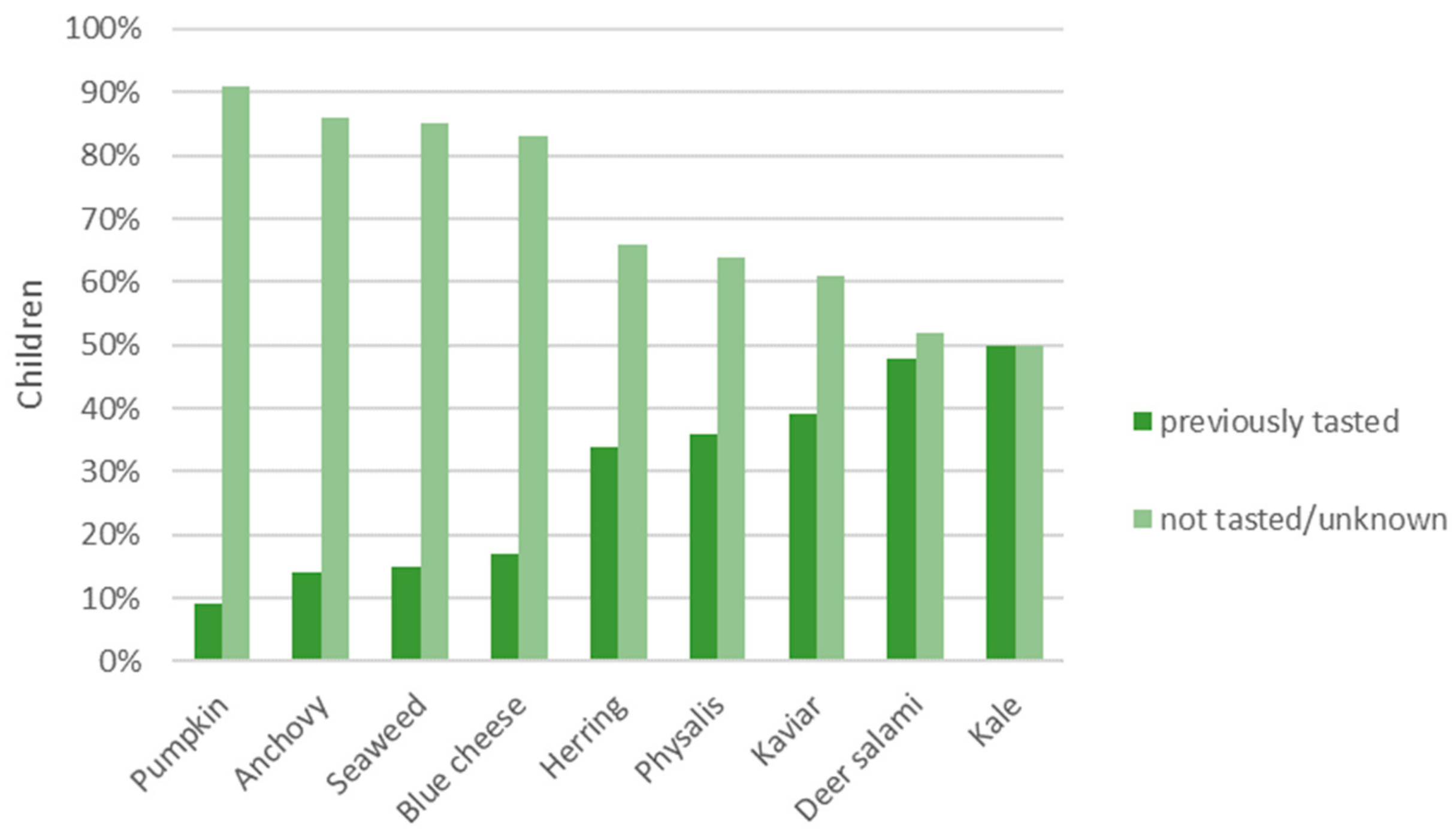
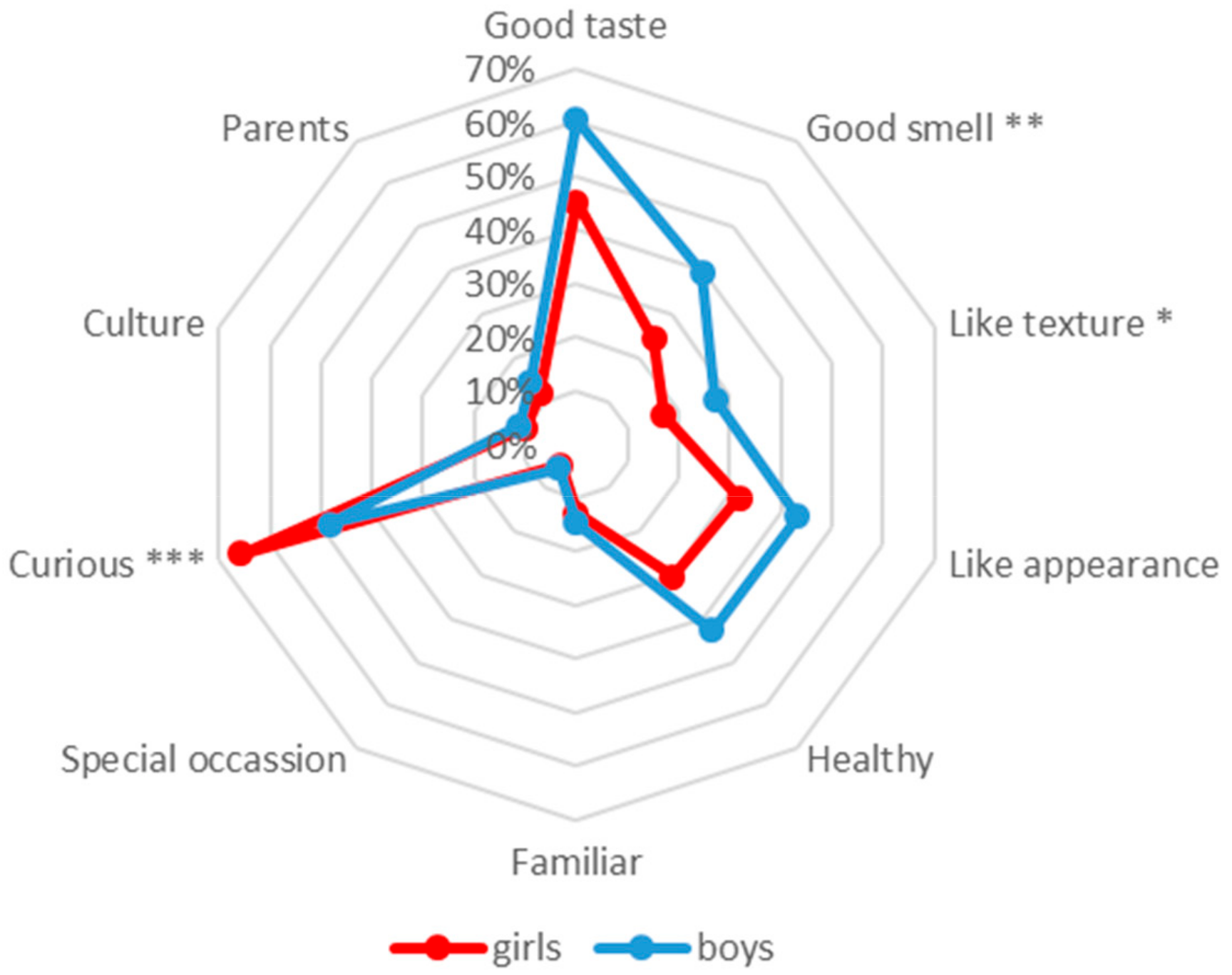
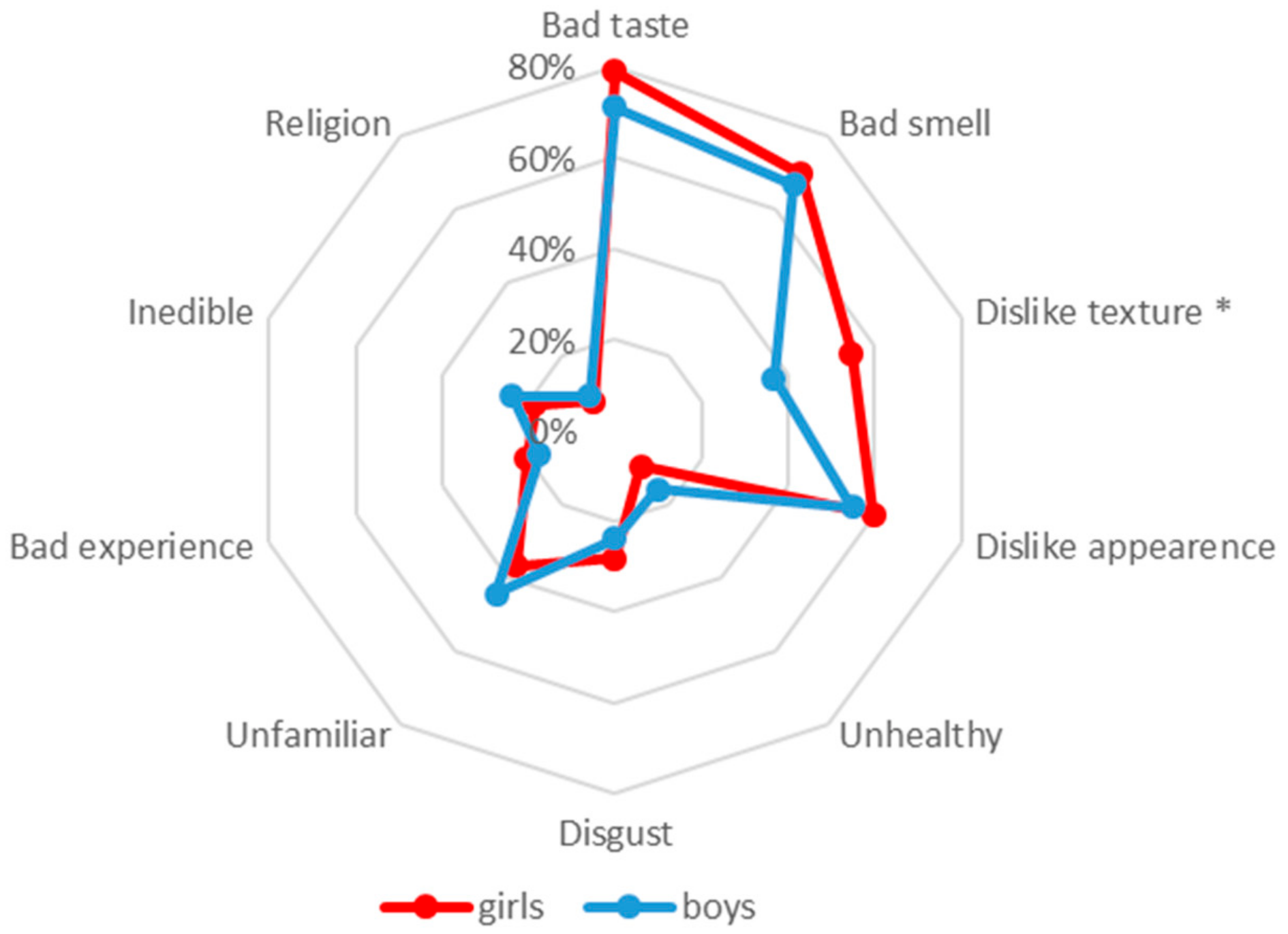
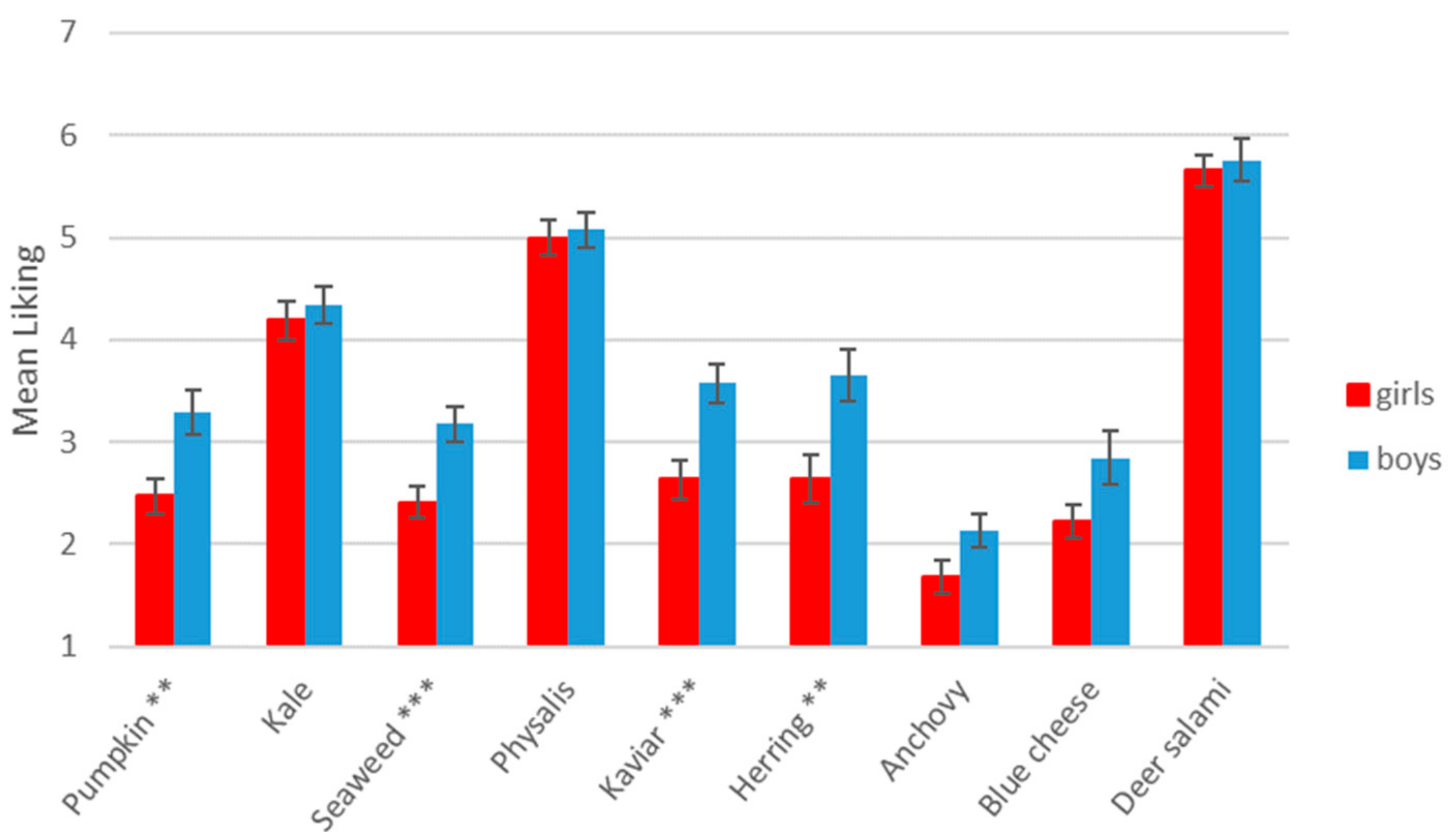
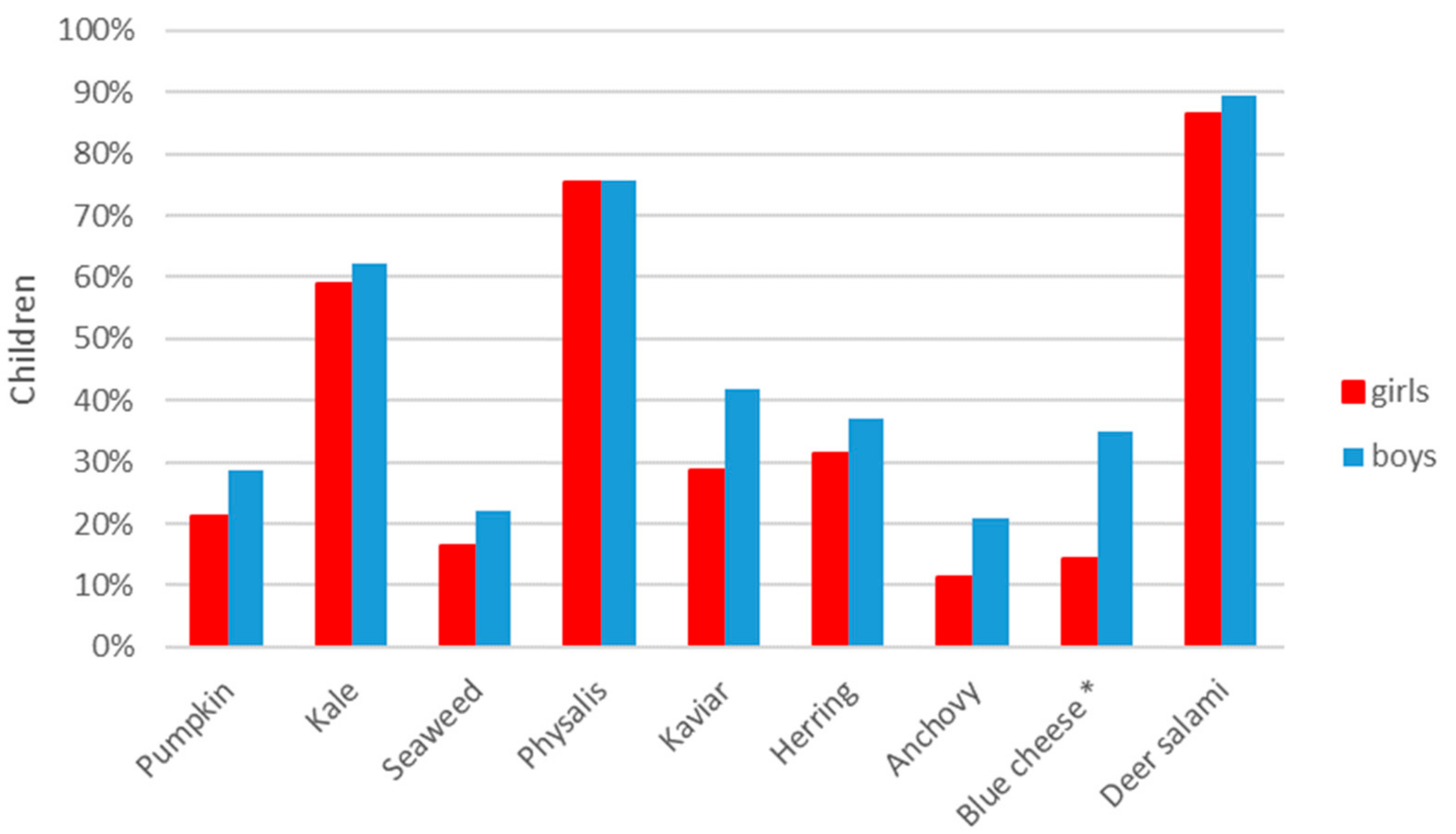
© 2019 by the authors. Licensee MDPI, Basel, Switzerland. This article is an open access article distributed under the terms and conditions of the Creative Commons Attribution (CC BY) license (http://creativecommons.org/licenses/by/4.0/).
Share and Cite
Sick, J.; Højer, R.; Olsen, A. Children’s Self-Reported Reasons for Accepting and Rejecting Foods. Nutrients 2019, 11, 2455. https://doi.org/10.3390/nu11102455
Sick J, Højer R, Olsen A. Children’s Self-Reported Reasons for Accepting and Rejecting Foods. Nutrients. 2019; 11(10):2455. https://doi.org/10.3390/nu11102455
Chicago/Turabian StyleSick, Julia, Rikke Højer, and Annemarie Olsen. 2019. "Children’s Self-Reported Reasons for Accepting and Rejecting Foods" Nutrients 11, no. 10: 2455. https://doi.org/10.3390/nu11102455
APA StyleSick, J., Højer, R., & Olsen, A. (2019). Children’s Self-Reported Reasons for Accepting and Rejecting Foods. Nutrients, 11(10), 2455. https://doi.org/10.3390/nu11102455




